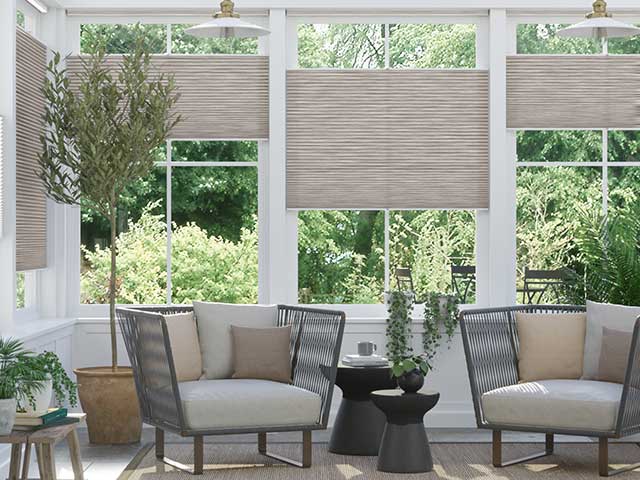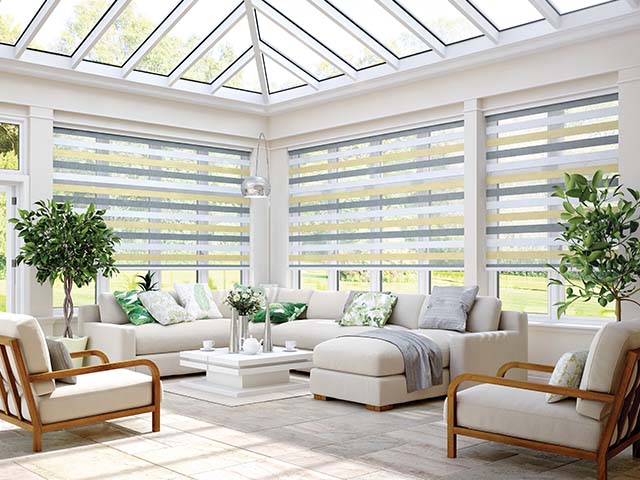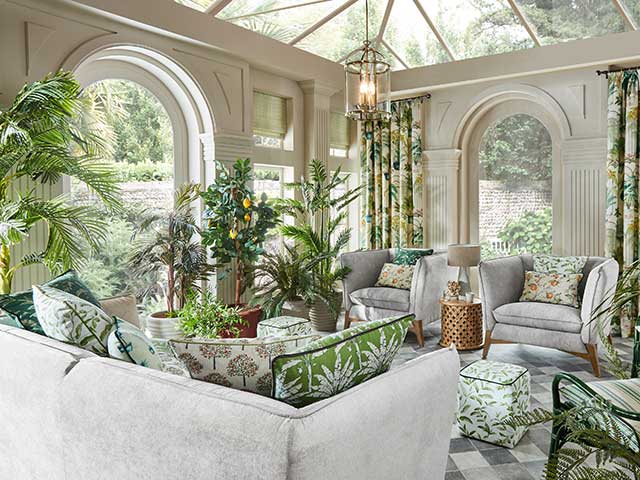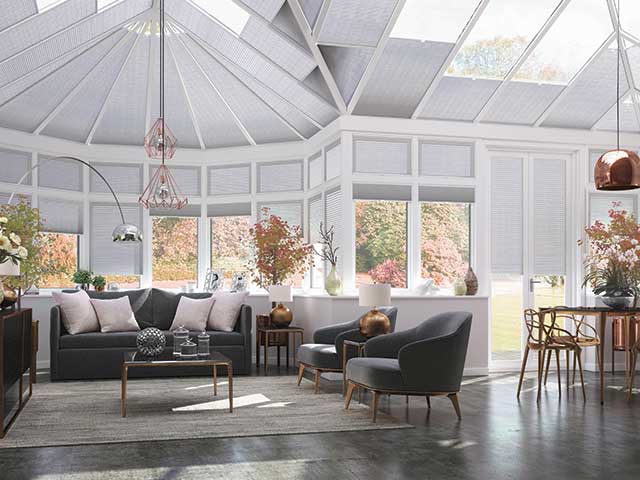
DuoLight Grain Fawn Top Down Bottom Up Thermal Blind
9 ways to keep your conservatory cool in summer
Wondering how to keep a conservatory cool? A gateway between indoor and outdoor living, the humble conservatory has come back into fashion of late.
With the abundance of natural light creating a calming atmosphere and offering a new perspective on your garden, a conservatory or orangery is a lovely spot to hang out in the summer – but only if you can keep it cool when the temperature starts to rise.

DuoLight Grain Fawn Top Down Bottom Up Thermal Blind from Blinds2Go
‘Keeping conservatories warm in the winter and cool in the summer is an age-old issue for anyone living with a conservatory,’ says David Downing, owner of ConservatoryBlinds4Less, ‘especially those looking to save money now that energy costs are rising.’
‘Conservatories, orangeries and other rooms with large windows and/or glass walls are vulnerable to heating up easily because they low in lots of light. You need to block out direct sunlight to avoid stifling heat building up – but this doesn’t mean sitting in the dark all day, which would defeat the point of the conservatory.’
One of the cheapest ways of keeping a conservatory cool is to add a cooling film to the glass, but if your addition is old, it might be worth fitting a replacement conservatory, or at least a new roof. This will be the best way to keep your conservatory cooler in summer and warmer in winter, thus saving money on your energy bills in the long run.
Here, Good Homes shares nine clever ways to keep a conservatory cool, some cheap and easy, others more of a long-term investment…
How to keep a conservatory cool
- Roof and window blinds
- Cooling film
- Furniture and decor choices
- Plants and trees
- Choose stone flooring
- Ventilation, ventilation, ventilation
- Air conditioning
- Ceiling fans
- Replace your conservatory roof
1. Roof and window blinds
Blinds are an obvious choice for keeping a conservatory cool because they are multi-purpose; other than helping to shield the room from sun, they give you a bit of privacy if your garden is overlooked and are also a great opportunity to add some style to your conservatory.
While most people opt for window blinds, tackling the roof is just as essential. Roof blinds are great for keeping the heat out in the summer but act as an insulator in the winter. You can order bespoke conservatory roof blinds to fit each panel of glass, so don’t worry if yours is a unique shape.
Also, knowing exactly when to open and close your blinds is important: ‘Make sure you are “pre-empting the sun”,’ says David from ConservatoryBlinds4Less. ‘This means shutting conservatory blinds and curtains before sunlight hits each window directly. So, before you go to bed, shut the blinds on any east-facing windows.
‘Installing roof blinds is a really great way to prevent conservatories from heating up when the sun is at its highest, which is between 11am and 1pm. These can be drawn to cover just the ceiling of the conservatory, allowing you to enjoy non-direct sunlight from all three-to-four sides without direct light from above heating up the space too much.
‘Make sure roof blinds and covers are closed before the midday mark and then shut blinds on windows towards the west before the sun makes its way over that way in the evening,’ he adds.

Window blinds, white floor tiles and light furniture help keep this conservatory cool. Photo: English Blinds
2. Cooling film
If you’re unwilling to replace your conservatory windows with a tinted glazing option, you can opt for cooling film. This is an adhesive layer that’s applied directly to the glass and reflects the majority of the sun’s heat, as well as harmful UV rays. This will not only help keep your conservatory cool, it will also stop your furniture from fading in the bright light.
‘When used in tandem with blinds, heat reflective window films are a great option for eliminating excess heat in conservatories,’ says David. ‘Some studies have shown that these films can reduce more than 75% of the sun’s heat from coming through your windows, which makes a significant difference in the temperature of the room. Window films are also an ideal option for those who don’t want to block out all of the natural light in their conservatory through the use of blinds.’
3. Furniture and decor choices
To keep a space cool, avoid cramming it full of bulky furniture. The less furniture, the more airflow and the cooler the space. To help keep a conservatory cool, opt for lightweight ‘breathable’ furniture like bamboo or rattan garden furniture – woven materials have plenty of gaps for air to pass through, aiding ventilation. Come winter, you can always use throws, sheepskins and cushions to create a cosier atmosphere.
Your colour palette matters too: ‘Darker colours, like black, dark grey and navy blue naturally absorb heat,’ says David. ‘This means that during periods where light is allowed in, they will become hotter and retain heat throughout the day and into the evening. On the flip-side, if you have lots of soft furnishing like rugs, throws and cushions in darker colours, you can effectively keep spaces warmer for longer during the winter.’
Consider shades of white, pastel colours and neutrals on the walls and floors, and use light, soft fabrics for furnishings and blinds. Equally, avoid leather furniture or heavy wooden pieces that can hold onto heat.
‘Soft fabrics such as cotton or linen will keep you cooler when sitting or walking on them,’ adds David.
View this post on Instagram
4. Plants and trees
By strategically planting a tree in your garden to shade your conservatory, you’re adding another layer of protection from the heat. If you want to let more light in during the winter to warm up the space, you can always get a deciduous tree that loses its leaves in the colder months.
‘Plants are an ideal way to reduce humidity, which can be an issue in conservatories and garden rooms that aren’t properly ventilated,’ says David. ‘Reducing the humidity in rooms is a great way to make a room feel cooler. Generally, humans can tolerated drier heat more effectively than wet heat, and so feel cooler if any excess air moister is released. Some great examples of light-loving, conservatory-friendly plants that have great dehumidifying properties include Lapageria, Plumbago, Sarracenia and Hymenocallis.’
Plants and trees are a natural and cheap way of keeping your conservatory cool that’s also good for the environment. Another way to make the most of nature’s air conditioning systems is to consider a cooling pond in your garden.
5. Choose stone flooring
Natural stone tiles are a good option to help keep your conservatory cool. Certain stones like slate or granite are known for being cool to the touch. There are pros and cons to each type of stone, and some varieties may need to sealing every few years, so it’s worth speaking with a flooring expert to find the best fit for your home.
Ceramic and porcelain tiles are also cool underfoot, but they are not if exposed to direct sunlight, so they may not be the best option for a glass-roof conservatory. Natural hardwood floors also feel cool to the touch and don’t retain as much heat as carpet. Whatever conservatory flooring you go for, especially if it’s in direct sunlight, choose lighter shades to help reflect the sun’s rays.

The Victorian Glasshouse collection from i-liv.co.uk
6. Ventilation, ventilation, ventilation
Opening windows and doors to let air into the conservatory to keep things cool may seem obvious, but as Allan Reid, the founder and CEO of Art Windows and Doors points out, opening your windows and doors on very hot days is likely to make your home even hotter, particularly in rooms that are already light-filled, like conservatories or orangeries.
‘Instead,’ says Allan, ‘it’s best to keep your windows and vents open in the early morning, evening and during the night, when temperatures are cooler. Then, when temperatures start to climb (which tends to be from 9-10am) close them. This will help to keep cooler air inside the home.
‘During the earlier hours of the morning, keep the windows open and the curtains or blinds fully drawn. This lets in cooler hair while stopping the rising sunlight from streaming in and heating everything up. Another great way to keeping everything cooler is by propping open your interior doors so cold air is pushed between different rooms.’
Also, you may not have considered getting vents installed in the roof and/or bottom of your conservatory to allow more hot air to escape. It is especially important to have vents or openings in the roof, since hot air rises.
7. Air conditioning
Air conditioning is the quickest way to cool down your conservatory, but it’s certainly not the cheapest, or the most environmentally friendly (not to mention contributing to those energy bills!).
An air conditioning unit can set you back anywhere between £500 and £5,000, but they do give you complete control of your conservatory’s temperature. Some offer both heating and cooling, meaning you can also tackle the problem of keeping your conservatory warm in the winter. It’s definitely one option to consider if you spend a significant amount of time in your conservatory.

Duette Thermal conservatory blinds by Thomas Sanderson
8. Ceiling fans
If you can’t face paying for air conditioning, then a ceiling fan will also do a pretty good job of keeping it cool by circulating air and creating a draft. Ceiling fans are only appropriate in rooms with ceilings at least eight feet high, and they work best when the blades are 7-9 feet above the floor and 10-12 inches below the ceiling. Larger ceiling fans can move more air than smaller fans. Of course, you could also opt for a floor fan or tower fan.
‘If you have fan or multiple fans, place them in the shadiest parts of the home pointed towards open doors to promote circulation of cooler air through the space,’ adds CEO. ‘In light-filled conservatories, for instance, it’s best to place a fan in an adjoining, shaded room and have it pointed towards the conservatory.’
9. Replace your conservatory roof
If you’ve tried all of the above and still can’t keep your conservatory cool, you may need a new conservatory roof with more thermally efficient materials. This may sound expensive, but it will mean your conservatory is cooler during the summer and warmer in the winter. Tiles, slates and composite panels will help to keep the sunlight out, and you could always add rooflights for a more balanced approach to natural light versus thermal efficiency.
MORE ON CONSERVATORIES:
- 5 conservatory decor ideas for year-round enjoyment
- Orangery or conservatory: What’s the difference?
- How to modernise an old conservatory




